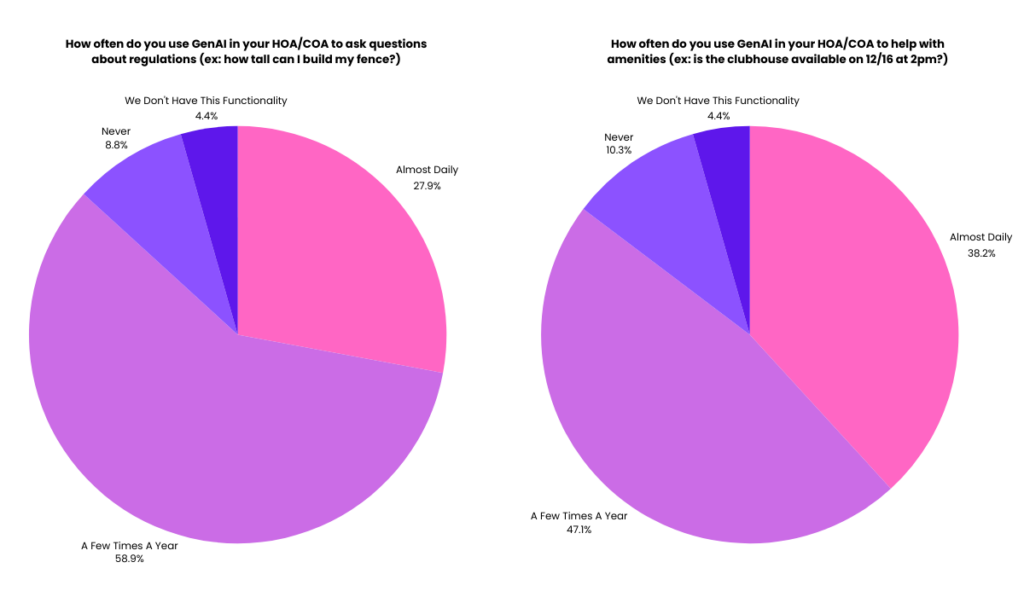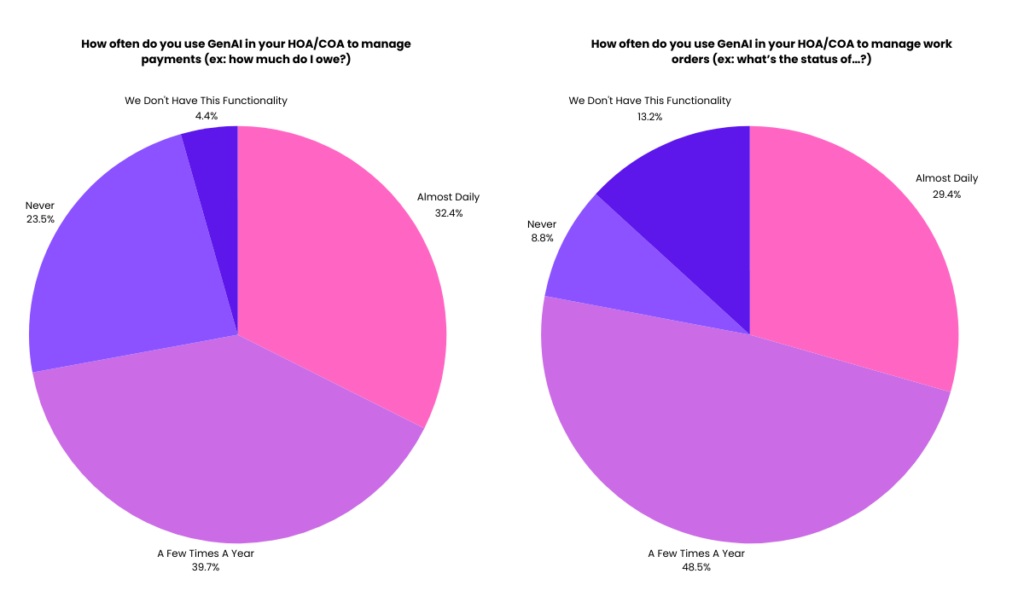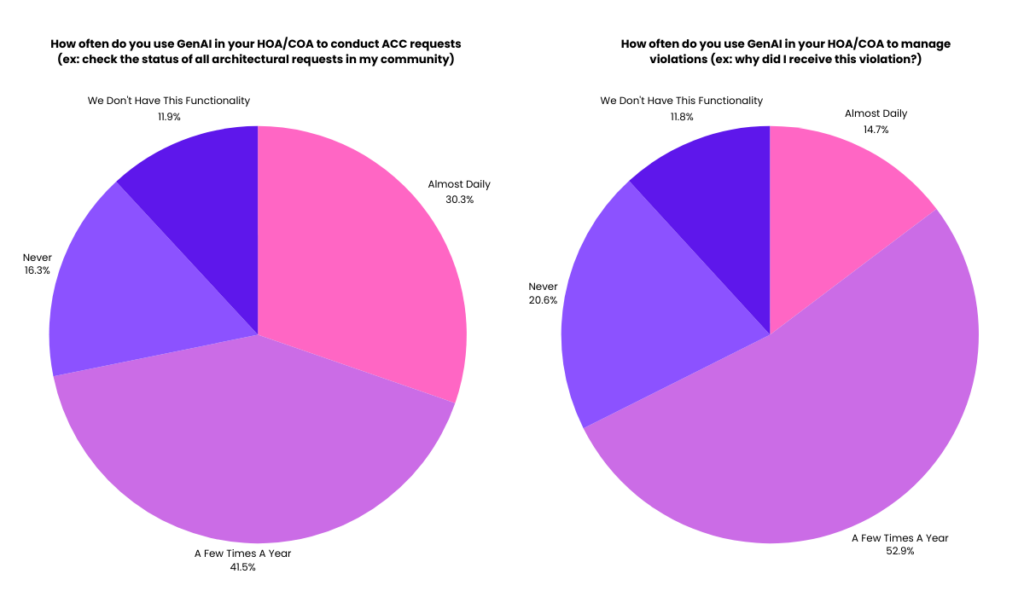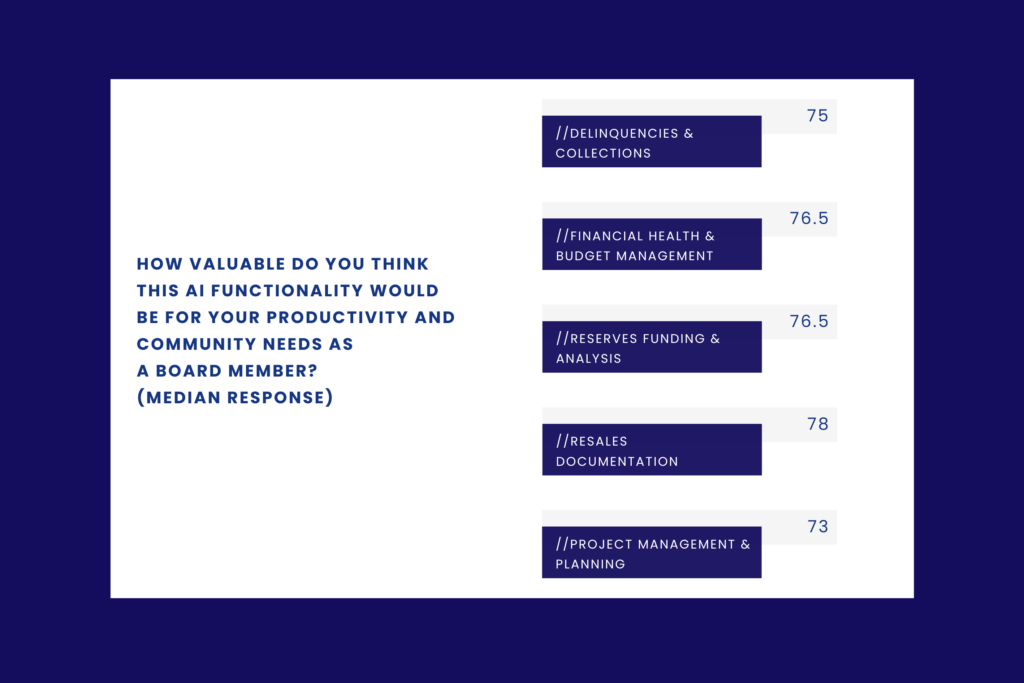Introduction
GenAI is revolutionizing the community association management industry, ushering in a new era of innovation and efficiency that’s reshaping how communities are managed. But with so many new GenAI products offered at breathtaking speed, it’s hard for executives to not only keep up with emerging offerings, but know what goes beyond a buzzword into a solution that drives meaningful value.
From enhancing productivity to driving bottom-line revenue, the focus of GenAI in 2025 shifts to tools that go beyond novelty. Instead, we are focused on tools that streamline operations, uncover actionable insights, and create measurable financial impact. To build smarter communities with GenAI, the solutions must not only deliver innovation but also demonstrate a positive return to the management company.
To help management companies in their buying process of new GenAI tools, we’ve developed the first-ever Buyer’s Guide for GenAI in Community Association Management. From HOA/COA Board feedback to revenue analysis and technological evaluation, organizations who read this will be set for success in their tech stack evaluation.
What's Inside
- Current Usage of GenAI in Community Association Management, as told by HOA/COA Board Members
- Top GenAI Board Requests to improve community engagement and productivity
- Revenue Generation Analysis to understand full return on investment
- Technological Considerations when evaluating GenAI solutions
GenAI in Action: Key Use Cases in Today’s HOA/COA Landscape
To move forward, we need to know where we stand today in GenAI usage within the HOA/COA landscape. This section will provide specific examples on GenAI usage from Board members.
Board Feedback: Current GenAI Usage
To understand current GenAI usage, we asked homeowners and Board Members who have GenAI in their HOA/COA software right now to specify how often they use various GenAI technologies. Their options were: 1. Almost Daily; 2. Seldom (A Few Times a Year); Never; We Don’t Have This Functionality. We asked about the following use cases: CC&R regulations, amenities booking, payment processing, work order management, violations management, and ACC request management.
Based on the responses, we can infer that homeowners and Boards are increasingly turning to GenAI to simplify everyday community management tasks, but the adoption and functionality of these tools slightly vary.


Survey respondents noted amenities booking as their most regularly used GenAI features within their HOA/COA, followed by payments management. It isn’t surprising to see a drop in usage for violations and work order management, as these tasks occur less frequently. It is surprising to see that 29 percent of homeowners reported never using GenAI to manage payments; this may indicate a continued lack of trust in GenAI for more serious and personal use cases, and software companies should take note.
The survey data about current GenAI usage also reveals unexpected gaps, with some homeowners reporting they don’t have access to GenAI for essential tasks like managing violations or ACC requests. This lack of functionality underscores the need for broader implementation and innovation to ensure GenAI tools meet the diverse needs of modern communities – and that the homeowners are aware of the technology within their platforms.
The adoption of GenAI where available falls in line with the evolution of applications over the past year. In the first introduction of GenAI, we witnessed monumental results in the reading and interpretation of static documents, such as CC&R regulations and governing documents. As GenAI capabilities evolved, we recognized the ability for the technology to interpret more personalized information, such as payment history and balances due. This form of GenAI is less available and can function poorly when designed haphazardly, so it is understandable why personalized use cases such as payment and work order management are still gaining traction.


Secure GenAI Frameworks: What Homeowners and Boards Need to Know
Survey feedback reveals that trust in data security is key to accelerating GenAI adoption. For management companies aiming to drive adoption of their solutions, prioritizing and promoting robust security frameworks is essential.
When GenAI operates within a software solution with advanced security standards, it safeguards homeowner data and the financial integrity of associations. In contrast, boards without integrated GenAI solutions who use open-source platforms for tasks like financial analysis expose their communities to significant risks of data breaches and privacy violations.
To build trust and ensure data security, management company executives should thoroughly evaluate their software provider’s security frameworks. By understanding and communicating the protection measures applied to their GenAI tools, executives can reassure boards and homeowners that their data is handled with the highest standards of privacy and security. With secure frameworks in place, GenAI can deliver its transformative benefits without compromising safety.
GenAI on the Horizon: What’s Next for Community Association Management
GenAI is transforming HOA and COA management, but the real opportunity lies in how it will adapt to meet the evolving needs of Board Members. To explore these questions, we specifically asked Board Members to answer questions about their needs. These survey results are from the same Board Members who answered questions about use cases in the previous section.
Survey Feedback: Future Use Cases of GenAI for HOA/COA Boards
Respondents were asked to rank the following in importance, with 1 being not at all valuable to 10 being extremely valuable:
How valuable do you think this GenAI functionality would be for your productivity and community needs as a Board Member:
- Managing delinquent accounts and sending collections-based communication, automated by homeowner communication preferences and state regulations.
- Financial health and management of budgets, invoices, accounts receivables, and accounts payable.
- Ensuring that reserves are properly funded, and providing suggestions to improve funding matters.
- The delivery and processing of resale documents for new homeowners.
- Project planning and management – generating to the board a timeline of deliverables and assignments per Board Member based on the scope of the project(s).
Most Valuable Functionalities
- Delinquent Accounts and Collections-Based Communication
- This was rated as highly important by the majority, emphasizing the critical role of managing homeowner payments and ensuring compliance with evolving collection policies.
- Financial Health and Budget Management
- The ability to oversee budgets, generate financial reports, and maintain accounting standards is a top priority for Boards, as it directly affects the financial sustainability of the association.
- Proper Reserve Funding
- Boards highly value tools that assist in planning and ensuring adequate reserves, as this is essential for long-term community health and avoiding financial crises.
- Resale Document Automation
- Automating the delivery and processing of resale documents was consistently ranked as important, likely due to the labor-intensive nature of this process and the risks for error.
Least Valuable Functionalities
- Project Planning and Management
-
- While valued, project planning was considered of lower importance than functionalities directly tied to financial management or compliance. Boards may perceive project planning as less urgent or easier to manage without advanced GenAI tools.
- Advanced Analytics and Reporting
-
- Although useful, tools that provide deep data analytics and forecasting seem to be viewed as “nice-to-have” rather than essential, especially for smaller associations with simpler needs.
Overall, these survey results indicate that GenAI is a welcome addition to Board Members for all areas of functionality that will improve productivity and make their volunteer roles simpler. With that said, Boards are most interested in tools that will offer advanced administrative benefits to complex matters that are often challenging to learn. Anything related to funding, financial health, AR recovery, and resale coordination should be a high priority for management companies to implement within their tech stack.

Key Takeaways
Based on current GenAI usage and requests for future GenAI use cases, we recommend that management companies focus on GenAI solutions that are focused on the following use cases:
- Amenities Management: Any solution that streamlines reservations of association amenities – such as the clubhouse or pickleball court – is clearly desired by homeowners and Board Members.
- Payment Processing: Homeowners should be encouraged to use GenAI to understand their upcoming payments, payment history, and outstanding balances.
- Collections: Boards are clearly interested in utilizing GenAI to recover AR faster and more efficiently – and to ensure they are in compliance with state regulations.
- Financial Management and Reserves Funding: Functionality that improves a Board’s ability to generate reports, analyze financial health, and review reserves are desired to support board members who wish to perform their role effectively and efficiently.
- Resale Document Processing: Boards indicate a strong need to improve the time commitment and overall organization of resale processes, creating better experiences for new homeowners.
Where Vision Creates Value: GenAI Technology that Actually Generates Revenue
Now that we’ve explored use cases in GenAI now and what HOA/COA Board Members would like to see in GenAI functionality, we now turn to one of the most crucial evaluations management company executives need to consider in their buying process: How to determine if the GenAI solution offered to your management company will actually bring more revenue.
There’s more to revenue generation in a GenAI solution that goes beyond an upcharge. To effectively evaluate revenue potential, management companies need to assess its financial impact across multiple dimensions, including labor efficiency, operational expenses, manual effort reduction, and customer retention. This holistic evaluation ensures that the investment aligns with strategic goals and delivers measurable returns. Here are a few essential calculations to consider:
Labor Savings
- Calculate savings achieved through automation of time-intensive tasks such as collections management, payment processing, and administrative support.
- Estimate the equivalent reduction in full-time employee (FTE) hours, enabling staff to focus on high-value tasks like client engagement and community growth. Consider whether this new solution would reduce headcount or realign headcount to other areas of the business.
Expense Reduction
- Assess the decrease in costs related to legal actions and other manual processes.
- Measure the extent to which GenAI streamlines compliance, avoiding penalties or inefficiencies caused by outdated processes.
- Consider hard costs eliminated through the GenAI solution, such as postage and printing.
Decreased Manual Efforts
- Quantify the improvements in efficiency derived from automating routine workflows, such as generating payment reminders or handling homeowner requests.
- Identify time savings that contribute directly to the solution provided, such as time spent recovering finances or explaining financial reports.
Client Retention and Satisfaction
- Understand how the solution improves customer satisfaction through personalized communication, efficient issue resolution, and reduced administrative friction.
- Consider how enhanced client experiences help retain clients and increase the likelihood of referrals, driving incremental revenue.
Applying Revenue Generation Principles - A TechCollect Example
Let’s say a management company oversees 10,000 units with a delinquency rate of 8 percent, which amounts to 800 units falling behind on their payments.
Delinquency Breakdown and Legal Costs Without TechCollect
Using the national average for HOA/COA collections, we can assume that 50 percent (400) units go unresolved and escalate to legal action, and let’s say that the legal fees are $4,000 per unit. This would lead to an annual cost of $1.2 million for legal fees for AR recovery.
Savings with TechCollect
By using TechCollect’s automated workflows to communicate to delinquent homeowners, that same management company could expect a 70 percent reduction in legal escalation. This would in turn reduce legal costs from an estimated $1.2 million to only $360,000. In addition, for their part in bringing this solution to their clients, management companies could expect new revenue of $296,110 annually.
Final Calculation:
- Legal Savings: $840,000
- Combined Partner Revenue: $296,110
Smart Questions for Smarter Technology: Key Considerations for GenAI Functionality
Now that we’ve reviewed homeowner and Board needs and completed a revenue analysis, we now turn to a few final questions management companies should ask GenAI solution providers to determine if the platform is right for them. These questions are paramount in determining the capabilities of technological sustainability and innovation within Generative AI.
1. Risk Management and Data Integrity
-
- How does the platform safeguard against data manipulation? Poorly designed GenAI systems are vulnerable to data poisoning, evasion attacks, and hallucinations, which can lead to costly errors. Ensure the platform uses advanced techniques like Uncertainty Quantification (UQ) or Retrieval Augmented Generation (RAG) to enhance reliability and accuracy.
- What measures are in place to prevent reasoning failures? GenAI models often struggle with complex logic or nuanced decision-making. Look for narrowly-designed systems for specific solutions that incorporate representation engineering to detect and correct biases or flawed reasoning.
- Can the platform handle diverse use cases without overfitting? Overfitting risks make GenAI solutions less adaptable to new data. Verify that the GenAI employs cross-validation and diverse datasets to maintain accuracy across various applications.
- Is the LLM specifically trained for this use case? Generalized language learning models aren’t going to cut it when it comes to complex issues in community association management, such as complying with state regulations or management of a resales process. Ensure that the product development team training the LLM has specific experience in the use case you are considering, and is training the LLM to be an expert on that particular issue.
2. Confidentiality and Security
- What privacy safeguards are implemented? Confirm whether the platform uses methods like differential privacy to protect individual data while allowing for secure analysis. This ensures compliance with privacy regulations and minimizes risks from breaches.
- How does the platform address unauthorized data access? Techniques such as unlearning are essential for mitigating risks like model inversion and black-box search attacks. Ensure the platform has robust protocols to remove sensitive data when necessary.
- Are there measures to prevent adversarial attacks? Ask about the system’s ability to defend against jailbreaking and prompt injection attacks, which can expose confidential data or override GenAI guardrails.
3. Governance and Accountability
- How does the platform promote ethical usage and transparency? Verify whether the vendor conducts regular audits for bias, transparency, and fairness. Ethical oversight is key to maintaining trust and compliance within the community association context.
- What mechanisms are in place to detect and manage deepfakes? Deepfakes can erode trust and spread misinformation. Ensure the GenAI solution includes advanced detection tools and watermarking to authenticate content.
- Does the platform include ongoing monitoring and feedback loops? Continuous improvement mechanisms, like Reinforcement Learning with Human Feedback (RLHF), are critical to adapting the platform to evolving use cases and minimizing harmful outputs.
4. ROI Alignment with Organizational Goals
- How does the platform quantify its impact on operational efficiency and revenue? A strong GenAI platform should demonstrate ROI through metrics such as increased collections recovery, reduced labor costs, and improved homeowner satisfaction.
- Does the platform integrate seamlessly into existing workflows? Ask whether the platform is compatible with current property management systems and if it reduces the need for additional administrative overhead.
Bringing Everything Together: Your GenAI Checklist
Now that we’ve explored client needs, revenue analysis, and technological implications, we can recap the buying process for a GenAI solution in community association management with one comprehensive checklist. We invite management company executives to use this checklist when considering various options for their management company:
1. Core Priorities for Boards
- Does the solution offered align with current popular GenAI usage across the HOA/COA industry for any of the following:
- Amenities Management
- Payment Processing
- Communications
- Does the solution improve productivity and simplify complexities where HOA/COA Boards request the most support:
- Collections Automation and Communications
- Financial Management
- Reserves Funding
- Resale Document Processing
2. Revenue Generation
- Can I quantify any of the following based on my conversations with the GenAI solution provider:
- Labor Savings
- Hard Cost Savings
- Manual Time Reduction
- AR Recovery
- AP Processing
- New Revenue via Upselling
- Am I able to quantify an estimated net positive return on investment?
3. Technological Considerations
- Is the LLM specifically trained to the use case for the GenAI Solution?
- Is the LLM trained against AI Hallucinations, Bias, and other issues that would cause inaccurate outputs?
- Does the solution provider employ sophisticated LLM training tactics, such as Uncertainty Quantification and Retrieval Augmented Generation?
- Does the GenAI Solution integrate with my software provider, and if not, is there a solution offered for proper integration?
Closing the Loop: Smart Return, Smarter Communities
The journey through GenAI adoption in community association management underscores one undeniable truth: technology must deliver measurable value to succeed.
As management companies evaluate their next steps, focusing on solutions that align with strategic goals, address client needs, demonstrate revenue opportunity and return on investment, and integrate seamlessly into existing systems is essential. By prioritizing trust, security, and tailored functionality, GenAI tools can turn challenges into opportunities – building smarter communities while ensuring a strong return for management companies.
